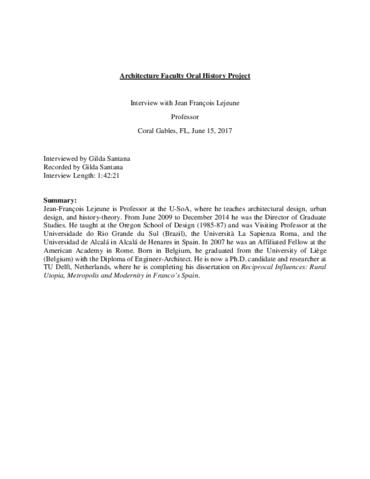Identity elements
Name and location of repository
Level of description
Item
Title
Interview Jean-Francois Lejeune, 15 June 2017
Date(s)
- 06/15/2017 (Creation)
Extent
PDF document
Name of creator
Biographical history
Gilda Santana joined the faculty of the University of Miami Libraries in 2007 as Head of Architecture Information and Resources to direct the Paul Buisson Architecture Library. She led the expansion and redesign of the library now called the Architecture Research Center (ARC) in 2018. Her research interests include facilitating the culture of design research through studio embedded-librarianship and the evolution of digital humanities in architecture and the arts. In 2013 she became the Librarian for Art & Art History. Santana has a Master of Science in Architecture from the School of Architecture, University of Miami, a Master’s in Library and Information Science from Rutgers, The State University of New Jersey, and a Bachelor of Art from Bard College where she majored in Art History. She actively serves in the Association of Architecture School Librarians (AASL) and the Art Libraries Association of North America (ARLIS).
Name of creator
Biographical history
Jean-François Lejeune is Professor at the U-SoA, where he teaches architectural design, urban design, and history-theory. From June 2009 to December 2014 he was the Director of Graduate Studies. He taught at the Oregon School of Design (1985-87) and was Visiting Professor at the Universidade do Rio Grande du Sul (Brazil), the Università La Sapienza Roma, and the Universidad de Alcalá in Alcalá de Henares in Spain. In 2007 he was an Affiliated Fellow at the American Academy in Rome. Born in Belgium, he graduated from the University of Liège (Belgium) with the Diploma of Engineer-Architect. He is now a Ph.D. candidate and researcher at TU Delft, Netherlands, where he is completing his dissertation on Reciprocal Influences: Rural Utopia, Metropolis and Modernity in Franco’s Spain.
In Europe, Lejeune collaborated on the design of the University of Liège Experimental Farm, and worked as urban designer for the Atelier de Recherche et d’Action Urbaines (Brussels) and for the Archives d’architecture moderne (AAM, Brussels). In Miami, he collaborated with various architecture offices like Duany Plater-Zyberk, Shulman and Associates, and Brillhart Architecture. His books include, among others, the three issues of the School of Architecture periodical The New City (1991, 1994, 1996), The Making of Miami Beach 1933-1942: The Architecture of Lawrence Murray Dixon (with Allan Shulman), Sitte, Hegemann, and the Metropolis (with Charles Bohl), Modern Architecture and the Mediterranean: Vernacular Dialogues and Contested Identities (with Michelangelo Sabatino, commended for the 2011 CICA Bruno Zevi Book Award) whose Italian version was issued in 2016. He has published essays in Rassegna, Stadtbauwelt, Architektur Aktuell, Clog, The Journal of Decorative and Propaganda Arts, Journal of Architectural Education, Bollettino del CE.S.A.R., and in various exhibition catalogues and books.
Lejeune’s research has also focused on Latin America and Miami and he is a founding member and secretary of DoCOMOMO-US/Florida. He curated in Brussels the exhibition Cruelty and Utopia: Cities and Landscapes of Latin America whose catalogue won the Julius Posener CICA Award for Best Architecture Catalogue in 2005. Other exhibitions include Cuban Architects at Home and in Exile: the Modernist Generation (2016-17, with Victor Deupi), The Florida Home: Modern Living in Miami, 1945-65 (Miami-Tallahassee, 2004-5, with Allan Shulman), Interama: Miami and the Pan-American Dream (Miami, 2008, with Allan Shulman).
He is currently at work on two monographs: Loos and Schinkel: The Metropolis between the Individual and the Collective (Routledge) and The Modern Village: Rural Utopia and Modernity in Franco’s Spain (DOM, Berlin).
Content and structure elements
Scope and content
Transcript interview to professor Jean-Francois Lejeune by Gilda Santana. Interview length: 1:42:21 min

